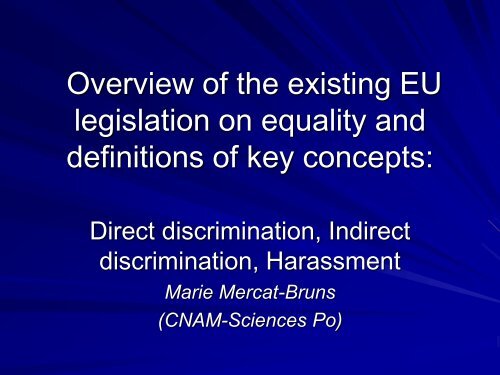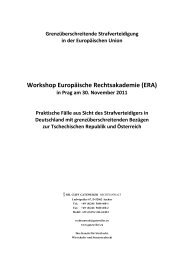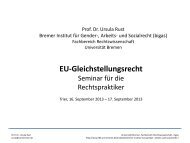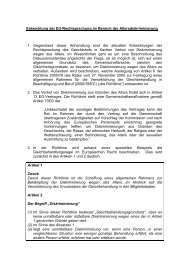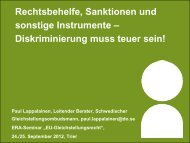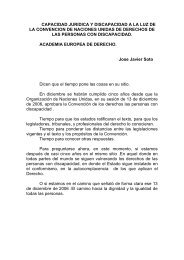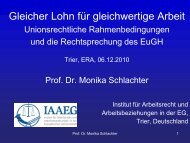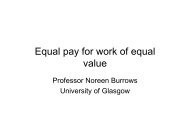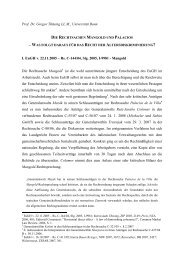non discrimination
non discrimination
non discrimination
You also want an ePaper? Increase the reach of your titles
YUMPU automatically turns print PDFs into web optimized ePapers that Google loves.
Overview of the existing EU<br />
legislation on equality and<br />
definitions of key concepts:<br />
Direct <strong>discrimination</strong>, Indirect<br />
<strong>discrimination</strong>, Harassment<br />
Marie Mercat-Bruns<br />
(CNAM-Sciences Po)
OUTLINE OF PRESENTATION<br />
INTRODUCTION ON THE ORIGINS OF EU EQUALITY AND NON-<br />
DISCRIMINATION LAW<br />
DIRECT DISCRIMINATION<br />
HARASSMENT AND SEXUAL HARASSMENT, A FORM OF<br />
DISCRIMINATION<br />
INDIRECT DISCRIMINATION<br />
EXCEPTIONS TO DISCRIMINATION<br />
CONCLUSION
Introduction : the origins of Equality and<br />
Non-<strong>discrimination</strong> Law in the EU<br />
The principle of EQUALITY and NON DISCRIMINATION are deeply<br />
anchored within EU law and the Treaties and now have given rise to<br />
a solid base of EU case law and laws interpreted in the Member<br />
States.<br />
Equality is considered as a fundamental principle recognized as<br />
such by the ECJ: «equal treatment between men and women is a<br />
fundamental right, part of the general principles of EU law which the<br />
Court must ensure the respect» (ECJ Defrenne III).<br />
This means that EQUALITY is a condition for the legality of any EU<br />
instrument or any action of EU institutions and agencies. Member<br />
States must also abide by it. NON DISCRIMINATION IS A MORE<br />
OPERATIONAL CONCEPT as is the concept of HARASSMENT<br />
and both involve UNEQUAL treatment.
Introduction : the origins of<br />
EU Equality Law<br />
How did the equality law framework develop? What part of this<br />
framework concerns more specifically concepts of <strong>discrimination</strong><br />
and harassment? Let us first focus on <strong>discrimination</strong> which implies<br />
harassment in its definition…<br />
Initially, the EU Treaty only covered sex <strong>discrimination</strong> with<br />
regards to equal pay (article ex 119 and 141 EC (now 157 TFEU)<br />
and <strong>discrimination</strong> based on nationality (art. 12 EC, now art. 18<br />
with the Lisbon Treaty) applying to persons,goods and services..) in<br />
order to remove barriers within the internal market. We will focus<br />
on equality and <strong>discrimination</strong> in employment. One speaker will<br />
focus on equal treatment in goods and services.<br />
We will discover that equality and anti<strong>discrimination</strong> rules in<br />
employment now cover the whole spectrum of events during a<br />
lifetime understanding the complexity of gender and family<br />
responsiblity <strong>discrimination</strong> as it is sometimes referred to.
Introduction : the origins of<br />
Non-<strong>discrimination</strong> Law in the EU<br />
It was not until the 1970’s, that, on the grounds of of sex equality,<br />
the ECJ case law (Defrenne I ECJ May 25 1971, Defrenne II April 8<br />
1976, C-43/75, et ECJ Defrenne III June15 1978, C-149/77) started<br />
to build standards for the concepts applied in the anti<strong>discrimination</strong><br />
legal framework of the member States. ECJ equal pay case law was<br />
also instrumental to understand wage <strong>discrimination</strong> when work was<br />
of equal value (see below).<br />
The Treaty of Amsterdam of 1997, in its article 13 (now art. 19),<br />
gave further impetus to this framework by expanding coverage of<br />
anti<strong>discrimination</strong> law to other grounds prohibiting <strong>discrimination</strong><br />
based on sex, racial or ethnic origin, religion or belief, disability, age<br />
and sexual orientation. Maternity and parental rights are also gaining<br />
in importance in relation to equality: ECJ Sari Kiiski C-116/06, EUCJ<br />
Gassmayr C-194/08
Introduction : the origins of<br />
Non-<strong>discrimination</strong> Law in the EU<br />
Indeed, article 13 of the Amsterdam Treaty invited « the Council acting<br />
unanimously on a proposal from the Commission and after consulting the<br />
European Parliament, » to « take appropriate action to combat<br />
<strong>discrimination</strong>… »<br />
The main directives covering the scope of employment were adopted:<br />
– Racial Equality Directive 2000/43 which covers race and ethnic origin (June 29<br />
2000)<br />
– Employment Framework Directive 2000/78 which covers religion, disability, age<br />
and sexual orientation (Nov. 27 2000)<br />
– Recast Directive 2006/54 covers sex <strong>discrimination</strong> in employment (consolidating<br />
a number of directives including directive 2002/73 and all relevant EU case law)<br />
– Directive 92/85 on the introduction of measures to encourage improvements in<br />
the safety and health at work of pregnant workers and workers who have<br />
recently given birth or are breastfeeding<br />
– Recently, the 2010/18 revised directive on parental leave<br />
– The 2010/41 directive on the application of the principle of equal treatment<br />
between men and women engaged in an activity in a self-employed capacity
Equal pay case law and 2006 DIRECTIVE<br />
(PREAMBLE): understanding systemic wage<br />
<strong>discrimination</strong><br />
ECJ equal pay case law was also instrumental to understand<br />
systemic <strong>discrimination</strong> based on the sexually segregated<br />
workforce. Since Enderby (C-127/92) for example and see the 2006<br />
Directive (point 8): the PRINCIPLE OF EQUAL PAY for equal work<br />
or work of equal value has CONSISTENTLY been UPHELD IN<br />
THE CASE-LAW and CONSTITUTES an important aspect of the<br />
principle of equal treatment between men and women<br />
See 2006 Directive Point (9) IN ACCORDANCE WITH SETTLED<br />
CASE-LAW of the Court of Justice: in order to assess whether<br />
workers are performing the same work or work of equal value, it<br />
should be determined whether, having regard to a range of factors<br />
including the nature of the work and TRAINING and working<br />
conditions, those workers may be considered to be in a<br />
COMPARABLE situation.
Concepts of <strong>discrimination</strong><br />
Direct <strong>discrimination</strong><br />
(disparate treatment <strong>discrimination</strong>)<br />
Indirect <strong>discrimination</strong><br />
(disparate impact <strong>discrimination</strong>)
Direct <strong>discrimination</strong><br />
Definition: three prongs<br />
Where one person is treated less favorably than another:<br />
- is<br />
- has been or<br />
- would be treated in a comparable situation<br />
On any grounds covered by EU Law
Direct <strong>discrimination</strong><br />
Where one person…<br />
is treated less favorably in a comparable<br />
situation (first prong):<br />
Without a comparator:<br />
ECJ Nov. 8 1990 Dekker, Case C-177/88
Direct <strong>discrimination</strong><br />
Where one person…<br />
- has been treated less favorably in a<br />
comparable situation (second prong)<br />
ECJ March 27 1980 Wendy Smith, Case<br />
129/79
Direct <strong>discrimination</strong><br />
Where one person…<br />
- would be treated less favorably in a comparable<br />
situation (third prong):<br />
ECJ April 30 1998. Caisse nationale d'assurance<br />
vieillesse des travailleurs salariés (CNAVTS) v Evelyne<br />
Thibault.<br />
Equal treatment for men and women - Directive<br />
76/207/EEC - Maternity leave - Right to an assessment<br />
of performance<br />
Case C-136/95
Direct <strong>discrimination</strong><br />
*- Discrimination by association:<br />
– Against a <strong>non</strong>-disabled employee because he or she is a carer of, or is otherwise associated<br />
with, a disabled person, ECJ Case C-303/06 Coleman<br />
*- Overt (smoking gun) Discrimination without an identifiable victim<br />
ECJ July 10 2008, C-54/07 (Feryn)<br />
The company Feryn specialises in making garage doors.The company DECLARES<br />
publicly a few years ago that it did not hire foreigners. According to the management,<br />
the company's clients did not want foreigners coming into their house.<br />
"There does not have to be a tangible victim. Public declarations, in and of<br />
themselves, can constitute the suspicion of <strong>discrimination</strong> and it is up to the employer<br />
to come up with proof to the contrary," ECJ OPINION.<br />
* Instruction to discriminate: ECJ Feryn (to please customers…)<br />
* Harassment
Harassment and sexual harassment,<br />
a form of <strong>discrimination</strong><br />
When an unwanted conduct takes place<br />
With the purpose or effect of violating a person’s<br />
dignity<br />
And of creating an intimidating, hostile,<br />
degrading, humiliating or offensive environment.<br />
Harassment and Sexual harassment: Directive<br />
2006/54, art. 2; Directive 2000/78, art. 2
HARASSMENT<br />
Hostile environment harassment (all<br />
grounds)<br />
Quid pro quo harassment (most often<br />
sexual in nature)
Indirect <strong>discrimination</strong><br />
Where an apparently neutral provision,<br />
criterion or practice would put persons having<br />
a particular racial or ethnic origin, religion or<br />
belief, sex, disability, age or sexual orientation at<br />
a particular disadvantage compared with other<br />
people<br />
Except if:<br />
this provision, criterion or practice is objectively<br />
justified by a legitimate aim and the means of<br />
achieving that aim are appropriate and<br />
necessary
Indirect <strong>discrimination</strong><br />
ECJ March 31 1981 Paula Jenkins, Case<br />
96/80<br />
ECJ December 6 2007 Ursula Voss, case<br />
300/06
Exceptions to <strong>discrimination</strong><br />
included in the 2006 Directive<br />
Not all differences of treatment qualify as <strong>discrimination</strong>:<br />
Genuine and determining occupational requirement<br />
(Directive 2006/54 art. 14)<br />
Positive action (art.157 TFEU and see Preamble of<br />
2006 Directive pt 22 )<br />
Protection of biological condition during pregnancy and<br />
maternity and measures to encourage improvements in<br />
the safety and health at work of pregnant workers and<br />
workers who have recently given birth or are<br />
breastfeeding; 2006 Directive is without prejudice to<br />
Directive 92/85/health and security and<br />
2010/18/parental leave (Preamble pt 24 and art.14/15 no<br />
<strong>discrimination</strong> after leaves)
Exception n°1 to <strong>discrimination</strong>:<br />
An occupational requirement<br />
Genuine and determining occupational requirement<br />
(Directive 2000/78 art. 4 and Directive 2006/54 art. 14)<br />
Member States may provide, as regards access to<br />
employment including training thereto, that a difference<br />
of treatment which is based on a characteristic related to<br />
sex shall not constitute <strong>discrimination</strong> where by reason<br />
of the nature of the particular occupational activities<br />
concerned or of the context in which they are carried out,<br />
such characteristic constitute a genuine and determining<br />
occupational requirement, provided its objective is<br />
legitimate and the requirement is proportionate.
Exception n°1 to <strong>discrimination</strong>:<br />
An occupational requirement<br />
Example ECJ Oct. 26 1999, Angela Maria<br />
Sirdar<br />
Angela Maria Sirdar v The Army Board<br />
and Secretary of State for Defence.<br />
Equal treatment for men and women -<br />
Refusal to employ a woman as a chef in<br />
the Royal Marines.<br />
Case C-273/97.
Exception n°2 to <strong>discrimination</strong>:<br />
positive action<br />
Positive action (2006/54, art. 3; 2000/43<br />
art. 5; 2000/78 art. 7)<br />
ECJ Kalanke Oct 17 1995, Case C-450/93<br />
ECJ Marshall Nov. 11 1997, Case C-<br />
409/95<br />
ECJ March 28 2000 Badeck C-158/97<br />
ECJ July 6 2000 Abrahamsson C-407/98
Exception n°3 : maternity and<br />
parental leave<br />
This protection concerns health and safty issues that<br />
specifically affect women and further regulated by<br />
Directive 92/85. Linked to protection of health of mother<br />
after birth and the «special relationship between mother<br />
and child » outside of stereotypical notions of women’s<br />
role described in ECJ Hoffmann C-184/83.<br />
Today case law revolves around giving adequate pay<br />
during pregnancy : for example if job transfer (see CJEU<br />
Parviainien July 1 2010)<br />
Proposed Change in Directive: minimal duration of<br />
maternity leave: 14 to 18 weeks and 6 after child birth.
Exception n°3: maternity and<br />
Parental leave:<br />
parental leave<br />
Revised Directive of 2010<br />
Case law: CJCE Meerts Oct 22 2009<br />
C-116/08
Conclusion: concepts require proof,<br />
effective remedies, enforcement and<br />
protecting family responsabilities<br />
Concepts require proof of <strong>discrimination</strong><br />
Concepts are worth nothing without effective remedies and enforcement: interesting case law on<br />
claims made by pregnant workers: national legislation can provide a specific claim when facing<br />
dismissal as long as the claim is not less favorable than ordinary claim and allows EU review :<br />
CJCE Pontin Oct 29 2009 C-63/08<br />
Equality bodies: guidelines for case law<br />
Commission’s role in promoting equality and employment <strong>discrimination</strong> law and an emphasis on<br />
work/life balance as a question for families and the EUCJ confirms through the recognition of<br />
parental rights:<br />
« Community policy in this area is to encourage and, if possible, adapt working conditions<br />
to family responsibilities. Protection of women within family life and in the course of their<br />
professional activities is, in the same way as for men, a principle which is widely regarded<br />
in the legal systems of the Member States as being the natural corollary of the equality<br />
between men and women, and which is recognised by Community law. » ECJ June 17 1998<br />
Kathleen Hill C-243/95


